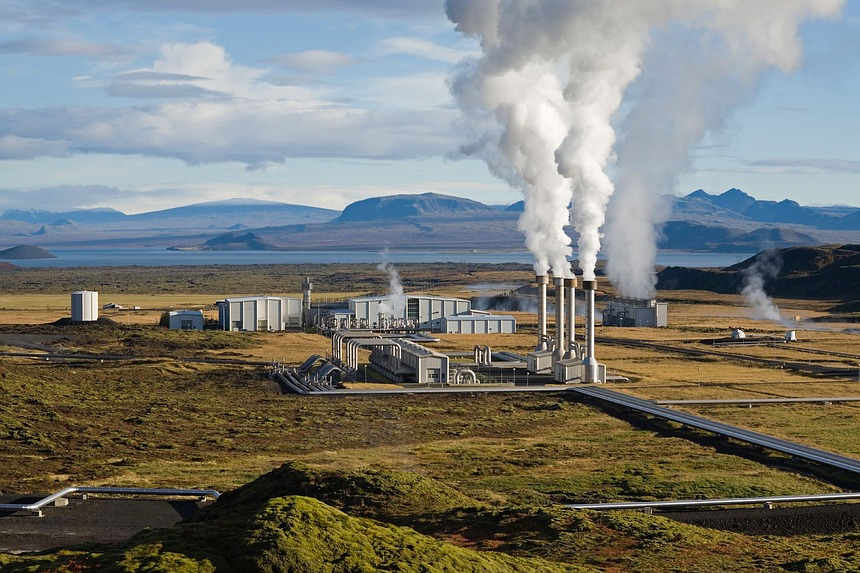Underneath our feet is practically endless energy. Although certain places like Iceland have geothermal heat near the surface, most of the planet must drill far deeper to exploit this possibility fully. The difficulty, then, is determining the cost and depth of drilling necessary. Still, the possible benefits of geothermal energy are great—a nearly limitless, always-available, green source of electricity.
How did Iceland turn into a geothermal success story?
Energy essentially bubbles to the surface in Iceland. The nation has simple access to geothermal energy, with about 200 volcanoes and scores of natural hot springs. Geothermal activity just under the Earth’s crust creates abundant hot water reservoirs. Iceland heats 85% of its homes with this clean energy since its geothermal resources have grown so efficient. Furthermore, 25% of its electricity comes from power plants using the heat of the Earth.
“Iceland is a fantastic example of how geothermal energy can become a mainstream energy source,” a geothermal energy specialist stated. “It’s an almost unlimited supply, always available, and with very low emissions.”
Apart from its availability, geothermal energy appeals because it is a renewable energy source free from reliance on temperature. Geothermal power is “always on,” constantly fed by the molten core of the Earth and the breakdown of radioactive materials in the crust, unlike wind or solar electricity. The Earth loses so much heat into space annually that it is sufficient several times to meet world energy use.
Still, geothermal energy needs to be fully exploited. With less than 700 units producing roughly 97 Terawatt hours (TWh) of electricity yearly, just 32 nations run geothermal power plants. This is less than half what solar electricity generates in the US alone. Notwithstanding these figures, scientists estimate that geothermal might provide as much as 800–1400 TWh of annual power by mid-century in addition to 3,300–3,800 TWh of heat annually.
What is the Geothermal Potential Deeper Beneath the Earth's Surface?
While Iceland is lucky to have geothermal resources close to the surface, many other areas must drill deep into the Earth’s crust to access the high temperatures required for producing energy or heating. Every kilometer into the Earth’s crust, temperatures rise by 25 to 30 degrees Celsius almost everywhere. For instance, the temperature at roughly 5 km deep in the UK is around 140°C.
Deeper below, though, water temperatures can rise above 374°C at pressures above 220 bars—the pressure at sea level is one bar. Water approaches an energy-intense condition known as “supercritical,” which is neither liquid nor gas but rather a highly energetic phase capable of generating notable power volumes at these depths. A single superhot geothermal well might produce five to ten times the energy generated in present commercial wells.
Why is it such a big challenge to drill deep enough?
Getting to these supercritical temperatures is the challenge. Conventional rotary drills—even those with diamond-tipped bits—are unsuitable. Due to the severe heat and pressures, drill components can break at such depths, and maintaining drill holes from being plugged presents continuous difficulty.
When a crew working on the Iceland Deep Drilling Project bore into a magma chamber of the Krafla volcano in 2009, they unintentionally entered supercritical conditions. Highly corrosive and difficult to regulate, the resultant superheated steam was utilized sparingly for two years before a valve failure sealed the hole.
Deep drilling takes time and money. After almost 20 years of operation, the Kola Superdeep Borehole in Russia descended to a depth of 7.6 miles (12.2 km). Still, using enormous geothermal resources is well worth overcoming these obstacles.
A 1-kilometer-deep geothermal well will cost roughly $2 million to drill; drilling to depths of 4km might run from $6 million to $10 million. Thanks to the higher temperatures and pressures accessible at deeper depths, profound geothermal energy provides the potential for significant cost savings, even if it is more expensive than ordinary geothermal.
Will new drilling technologies under development help reach the heat?
Researchers and creative businesses have been developing new drilling technology to reach the Earth’s subsurface heat source in recent years. One such company, Quaise Energy, a Massachusetts Institute of Technology (MIT) spin-off, seeks to drill holes down as far as 12 miles (20km). They are now adopting a new method: vaporizing rock using intense millimeter-wave energy beams.
“Our technology has the potential to completely transform geothermal drilling; it is based on the same technology used for nuclear fusion research,” claimed a co-founder of Quaise Energy.
Using a focused, high-powered radiation beam, millimeter-wave drilling melts rock at temperatures as high as 3,000°C (5,432°F), transforming it into vapor. This approach could make faster and more effective drilling possible, allowing drilling to proceed free from the friction and waste produced by conventional drilling methods. Highly promising for reaching the extreme depths needed for supercritical geothermal energy, the process runs essentially independent of depth.
Though this technology has only been tested in a lab environment, Quaise Energy says it can drill through rock at roughly 3.5 meters (11.5 feet) per hour. The main benefit of the “drill bit” is that it does not physically grind through the rock, so there is no wear or need for frequent replacements, even if it is slow compared to conventional techniques. Currently undergoing the last stages of laboratory testing, Quaise Energy anticipates starting field trials in 2025.
How Might Pulse Plasma Drills Provide a Fix?
Based in Slovakia, GA Drilling is developing yet another exciting technology. It works on a pulse plasma drill employing high-energy electric discharges to split rock apart without melting it. The drill breaks rock by ionized gas, reaching temperatures up to 6,000°C (10,832°F) by providing brief energy pulses.
“Pulse plasma drilling allows us to disintegrate rock without causing the issues of molten rock that can stop traditional drills,” the GA Drilling CEO remarked. With longer-term targets of reaching 10km or beyond, the corporation intends to drill to depths of 5–8 km in the not-too-distant future. Archers from the Geothermal Energy and Geofluids (GEG) group in Germany and Switzerland, working together to create sophisticated mathematical models for managing supercritical fluids utilizing plasma drilling, have also expressed interest in the technology.
How may technology related to space exploration support deep-earth drilling?
Fascinatingly, some technologies meant for Venus, where temperatures reach 475°C (887°F), are now used for geothermal drilling. Electronics manufacturers such as Ozark Integrated Circuits are customizing circuits designed to survive high temperatures and be used in deep geothermal drilling platforms.
Part of this technological push is artificial intelligence. The National Renewable Energy Laboratory (NREL) is using artificial intelligence to examine intricate subsurface habitats, guide the best locations for drilling for supercritical water, and foretell possible drilling issues before they start.
How is the Closed-Loop System developed by Eavor transforming Deep Geothermal Energy?
Using some of Europe’s most giant land-based drilling rigs, the geothermal company Eavor declared in 2024 that it had effectively dug to 3 miles (5km) at its site in Geretsried, Germany. Known as the Eavor Loop, Eavor’s creative closed-loop geothermal technology pumps water underground to be heated by the Earth’s inherent heat, bringing it to the surface to run households and create power.
“We think we can drill up to 11 km in the future and unlock super hot rock,” stated an Eavor co-founder. Unlike conventional open-loop geothermal systems, this one is a greener and more sustainable solution since it eliminates problems, including pollution and hazardous gas emissions.
Eavor’s method also requires less surface area, which would make it feasible for future metropolitan sites. Still, maintaining deep geothermal wells and clearing blockages is a big task.
In essence, can we unlock profound geothermal energy?
Profound geothermal energy might be a solution as the globe seeks to switch to greener energy sources. Though much has to be done to overcome the technological and financial obstacles, it offers sustainable, low-emission power for the future. With creative drilling techniques, one day, deep geothermal power could become a mainstream energy source as the competition to access the heat of the Earth intensifies.








